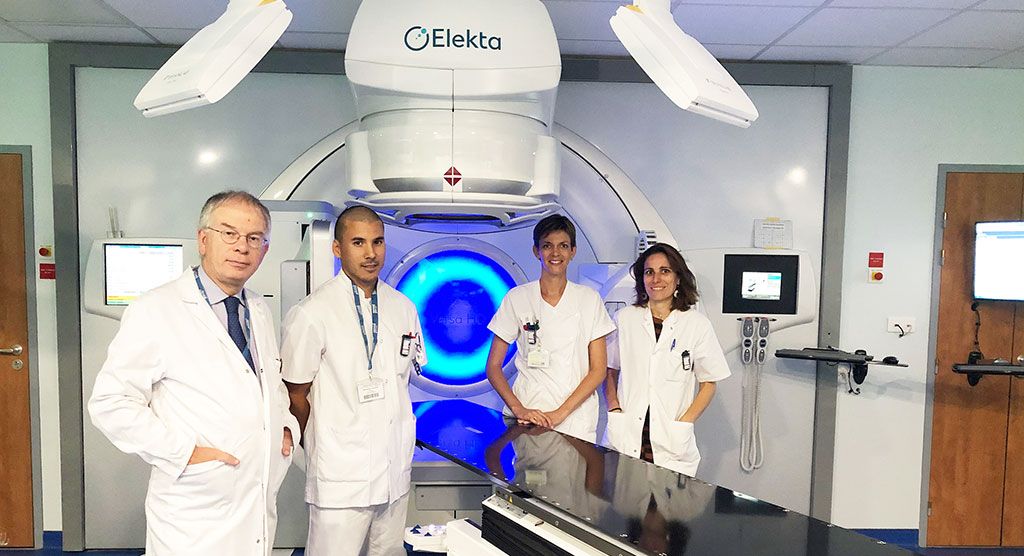Collaboration leads to new options for liver cancer patients

Clinical study reports interstitial brachytherapy shows modality’s advantages over SBRT for select patients
Interstitial brachytherapy’s one-day treatment visit, improved dose coverage and lower radiation exposure to healthy liver tissues were the findings of a recent first-of-its kind study1 that compared interstitial liver brachytherapy (BT) treatments of 85 patients with virtual stereotactic body radiation therapy (SBRT) plans created for the same patients. The comparative analysis, published in Brachytherapy, examined the dosimetric properties of both techniques.
Currently, SBRT is the standard method for local ablative treatment of liver primary tumors and metastases by virtue of its ability to irradiate small target volumes over a relatively small number of fractions, as well as its precision and sparing of healthy tissues and organs-at-risk (OARs). While interstitial BT has not been used extensively for liver lesion ablation, the technique has recently been added to “the toolbox of ablative treatment options” of the European Society for Medical Oncology (ESMO) for metastatic colorectal carcinoma and hepatocellular carcinomas (HCCs), the study2 authors note.
“It is known that brachytherapy accomplishes similar results to SBRT and radiofrequency ablation when BT is used to treat liver lesions,” notes study co-investigator Stefanie Corradini, MD, radiation oncologist at University Hospital, Ludwig-Maximilians University (Munich, Germany). “BT’s local tumor and control rates are more than 80 percent at one year depending on tumor size.”
A video of an interstitial BT case at LMU can be viewed here.

Brachytherapy treatment and virtual SBRT planning
The clinical BT/virtual SBRT study was a collaborative effort between interventional radiologists in the department of radiology and brachytherapy specialists in the department of radiation oncology at University Hospital Magdeburg (Germany), where the 85 consecutive patients were treated. The inoperable patients had either a primary liver tumor or up to six liver metastases.

Interstitial brachytherapy – step by step
With the patient sedated and in the supine position, interventional radiologists used fluoroscopic CT to guide hollow 17-gauge needles into the liver lesion(s). Then, they inserted an angiography sheath over an angiography wire and the brachytherapy catheters were consecutively placed in the sheaths.
Following catheter placement, the team acquired a contrast-enhanced planning CT using a breath-hold technique and slice thickness of three millimeters.

Planning was done with Elekta’s Oncentra® treatment planning system for delineating the gross tumor volume (GTV) and adding a 3-5 mm margin for the clinical target volume (CTV). OARs such as the liver, stomach, duodenum, colon, small intestine and heart were also delineated.
“There is no extra margin for the PTV because there are fewer setup inaccuracies for brachytherapy versus external beam radiotherapy and also that the brachytherapy catheters are fixed within the lesions,” Dr. Corradini notes.
The radiation oncology physicist then reconstructed the catheters and completed treatment planning and dose optimization. The PTV prescription dose was either 15 Gy (HCCs and breast cancer mets) or 20 Gy (cholangiocellular carcinoma, secondary liver lesions, e.g., colorectal carcinoma).
BT was delivered in a single session averaging 30-40 minutes with an Elekta Flexitron® HDR afterloading system.
During BT catheter removal, gel foam was rolled into cylinders and inserted through each BT sheath to prevent bleeding complications.

Virtual SBRT
The researchers developed virtual SBRT plans for all of the liver lesions, using the original BT planning CTs with the BT catheters in place. To account for organ motion, they added extra GTV margins to reflect respiratory-related organ motion (5 mm lateral, 10 mm craniocaudal).
The SBRT plan prescription dose – 15 Gy/20 Gy in one fraction – was the same as the BT plans and was prescribed to 99.9 percent of the PTV.
“The PTV dose was designed to satisfy the specified prescription dose, but we reduced it if would violate the maximum OAR dose limits,” Dr. Corradini says. “The same OAR constraints for SBRT treatment planning were used for BT planning.”
Better dose coverage, liver dose exposure with brachytherapy
The clinically delivered BT demonstrated superior dose coverage versus the virtual SBRT plans, the researchers found.
“The D99.9 for the BT plans was closer to the 15 Gy or 20 Gy prescription dose,” she notes. “For the 20 Gy group in particular, the BT plans attained a mean D99.9 [19.9 ± 0.4 Gy], compared with the mean of the SBRT plans [17.5 ± 0.5 Gy].”
The impact was more prominent for the D90, Dr. Corradini added, with a mean D90 of 24.3 Gy ± 0.8 Gy for the 15 Gy BT group, versus a mean of 16.5 Gy ± 0.3 Gy for the SBRT plans. In the 20 Gy group, the mean D90 recorded was 20.6 ± 0.3 for SBRT, while the BT mean was 29.2 ± 0.4.
The choice of modality also affected the liver dose exposure (V5Gy), with a significant statistical difference shown for the 20 Gy group. The V5Gy for BT was 611 ± 43 cm3, whereas the V5Gy value for SBRT plans was 694 ± 37 cm3.
“That corresponds to about four percent less liver dose exposure for brachytherapy,” she notes. “This is mainly due to the doubling of the median PTV.”
A viable option for select liver cancer cases
Whereas SBRT is constrained by the limited number and maximum diameter of treatable liver lesions of four to six centimeters, BT enables clinicians to treat tumors of a larger size range – using single doses of 15 Gy to 20 Gy with local control exceeding 90 percent in large primary or metastatic liver lesions measuring up to 12 to 15 centimeters, the researchers noted.
Dr. Corradini pointed to several additional advantages of brachytherapy over other therapies.
“Compared with thermoablative treatments, interstitial brachytherapy can offer an effective option for large and centrally located liver lesions,” Dr. Corradini observes. “It is also less affected by uncertainties associated with patient breathing motion, because the tumor is fixed in place by the BT catheters. Another benefit is that BT can be repeated more easily, enabling us to apply it with a hypofractionated approach [2-3 fractions] to spare organs-at-risk or treat very large tumors.
“Taking into account these advantages and the results of this comparative analysis,” she concludes, “interstitial brachytherapy should be considered an attractive, minimally invasive treatment option for a subset of patients with liver malignancies.”
- Hass P, Mohnike K, Kropf S, et al. Comparative analysis between interstitial brachytherapy and stereotactic body irradiation for local ablation in liver malignancies. Brachytherapy 2019; in press. DOI: https://doi.org/10.1016/j.brachy.2019.08.003
- Annals of Oncology 0: 1–37, 2016 doi:10.1093/annonc/mdw235, ESMO consensus guidelines for the management of patients with metastatic colorectal cancer
Interstitial liver brachytherapy at LMU
The LMU interstitial liver brachytherapy began at LMU in 2017, a collaboration between the departments of interventional radiology and radiation oncology. Indications include primary tumors (HCC, CCC) and oligometastatic disease.
Patient selection depends on treatment intent. Surgery is typically performed with curative intent and local ablation (thermoablation, radiation [SBRT or interstitial BT]) is usually employed for palliative cases.
When the patient is selected for palliative radiation therapy, the following criteria generally apply:
SBRT
- Single lesion
- Smaller-sized lesion
Interstitial BT
- Multiple lesions
- Irregularly shaped lesions
- Lesion close to OARs (stomach, heart, colon)





